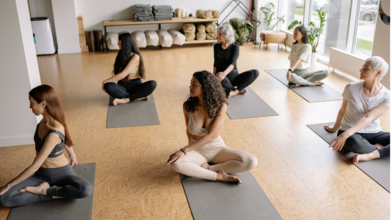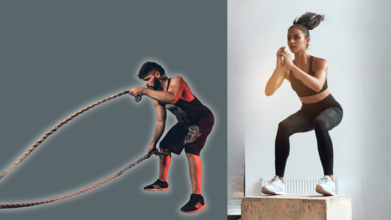- Health Conditions A-Z
- Health & Wellness
- Nutrition
- Fitness
- Health News
- Ayurveda
- Videos
- Medicine A-Z
- Parenting
- Web Stories
How Exercise Lowers The Risk Of Breast Cancer? Ways To Use Aahar, Vihar Achar And Vichar

How Exercise Lowers The Risk Of Breast Cancer?
Breast Cancer is a common disease among women worldwide. There are several risk factors of this type of cancer including age, family, history, and lifestyle factors such as diet and obesity. According to research, engaging in regular physical activity can lower the risk of getting breast cancer. Any form of physical exercise regulates hormones, especially reducing the increased level of estrogen, which is a hormone associated with breast cancer.
Also, physical exercise plays a significant role in maintaining the hormonal balance. Here’s how exercise lowers the risk of breast cancer.
On practicing regular physical activity, it is easier to maintain a healthy weight. Mostly after menopause, the weight of a woman increases, which is linked to an increased risk of breast cancer due to high levels of estrogen.
Exercising helps in regulating hormones, like estrogen and insulin, which plays an important role in breast cancer development.
When regularly exercised, it boosts the immune system, which helps the body to detect and remove cancerous cells more effectively.
Regular exercise improves insulin sensitivity and glucose metabolism, which helps in lowering the risk of cancer. Physical activity improves mental health and reduces stress, which potentially lowers cancer risk.
Engaging in regular moderate to vigorous exercise is recommended as part of a healthy lifestyle to help reduce the risk of breast cancer. Meanwhile, Yoga is one such holistic approach and science that immensely benefits the physical and psychological health of breast cancer patients. Yoga focuses on four important pillars – Aahar, Vihar, Achar and Vichar.
Aahar (food)
Chemotherapy often changes taste and appetite; hence, nutrition is very important. This includes having iron-rich foods (spinach, lentils), high intake of liquids, and vitamin-C rich foods in daily diet. Patients should eat sattvik food which is light and easy to digest. One should have small meals on regular intervals and avoid alcohol, junk and processed/packaged foods.
Vihar (rest and recreation)
Post-treatment, taking rest is important for patients and they should listen to their bodies. It is highly recommended that one engages in activities that bring joy like spending time in nature, meditating, practicing relaxation techniques like Shavasana. All these help in reducing anxiety levels, stress and relaxes the body and mind.
Achar (behavioural pattern)
Slowly one can get back to their daily routine and tasks which will build their physical strength, mental engagement and their confidence levels. Follow good hygiene in order to protect yourself from infections and practice pranayama as it improves immune functioning and reduces stress. One can also practice asanas like Talasana and Goumukhasana which improves circulation and supports fast recovery. Apart from this, one can practice Marjariasana-Bitilasana and Matsyasana to prevent breast cancer.
Vichar (thought patterns)
One can practice Pratipaksha Bhavna that helps in replacing negative thoughts with positive thoughts. Also, on a daily basis, one should write 10 positive points which will help develop an increased gratitude and optimistic attitude. Developing attitude of Ishwar Pranidhana encourages surrendering your worries to a higher power. One can also connect with others who have overcome cancer and can also provide encouragement and perspective.
Landon Dickerson Suffers From A Right Leg Injury: What Are The Common Football Injuries And How Can You Prevent It?

Credits: Wikimedia Commons
The Philadelphia Eagles’ Pro Bowl left guard Landon Dickerson was helped off the field and later carted inside after suffering an apparent right leg injury during the team’s open practice Sunday night at Lincoln Financial Field.
The incident happened late in the more than two-hour practice during a pass play, when quarterback Jalen Hurts connected with running back Saquon Barkley on the opposite side of the field. Dickerson went down and stayed on the ground for several minutes, surrounded by teammates as a hush fell over the crowd of nearly 50,000 fans.
Also Read: 3 Common Yoga Mistakes That Could Be Limiting Your Progress
Unable to put much weight on his right leg, Dickerson was assisted off before riding a cart indoors. He was replaced in the lineup by Brett Toth.
The injury comes a day after Dickerson appeared on the team’s injury report with a knee issue, which limited his participation in practice on Saturday. He was not listed on the report for Sunday.
What Are The Common Injuries in Football?
Football players are more likely to get hurt during matches than during training, with risks coming from tackling, sprinting, twisting, jumping, or even repeating the same movements until fatigue sets in. Collisions, poor conditioning, or re-injuring a previously weakened area can also contribute.
Sprained Ankle
Quick changes of direction and uneven surfaces make ankle sprains one of the most common football injuries. This happens when the ankle rolls inward or outward, overstretching the ligaments.
Management: Follow the POLICE principles: Protect, Optimal loading, Ice, Compression, Elevation, and avoid HARM factors: Heat, Alcohol, Running, Massage, in the first three days.
Hamstring Strain
Hamstring muscles power a player’s acceleration. Sudden bursts of speed without adequate flexibility or strength can cause a strain.
Management: Use POLICE and HARM steps. Prevention includes stretching, foam rolling, and strengthening exercises like deadlifts, leg curls, and bridges.
Groin Strain
Twisting, kicking, or rapid directional changes can strain the inner thigh muscles, also known as adductors.
Management: Same POLICE and HARM, with prevention through regular stretching and strengthening exercises such as side lunges and adductor side bridges.
ACL Injury
The anterior cruciate ligament is critical for knee stability. Injuries often occur when the lower leg stays planted while the upper leg twists, during tackles, or awkward landings.
Management: Mild sprains may heal with physiotherapy, but severe tears often require surgery. Persistent swelling or pain should be checked by a professional.
Preventing Football Injuries
- Strengthen lower limbs with exercises like squats, lunges, and calf raises.
- Warm up with dynamic stretches and sport-specific drills.
- Cool down after matches to aid recovery.
- Wear proper gear, including fitted boots and shin guards.
- Stay hydrated, eat well, and rest between games.
3 Common Yoga Mistakes That Could Be Limiting Your Progress

Yoga, at its heart, is a journey of balance, patience, and self-awareness. Yet, even regular practitioners can unknowingly fall into habits that limit progress or compromise the essence of the practice. Celebrity nutritionist Rujuta Diwekar, who works with stars like Kareena Kapoor, Alia Bhatt, Varun Dhawan, Saif Ali Khan and Karisma Kapoor, recently shared three common yoga mistakes that many of us make and how to correct them. Her advice is simple, practical, and rooted in tradition.
1. Always Starting With the Right Side
The first, she says, is starting every asana from the right side. “Because what happens is that we stay on the right side for a long time and on the left side for a short time. And because of that, the weakness of the left side remains. And the overall imbalance in the body also remains.”This habit, she explains, can unconsciously deepen the existing imbalances in the body. Yoga, after all, is a practice of samatva or balance. The aim is not to favour one side but to restore equilibrium—physically, mentally, and emotionally.
She suggests a simple correction. Yoga should be done with awareness. She says how even sitting postures like Sukhasana should be alternated to ensure both sides of the body are equally engaged. Start from the weaker or underused side. It may feel awkward initially, but over time, it helps realign the body and build balanced strength.
2. Only Practising the Asanas You Are Good At
Rujuta points to the second mistake: “The asanas that we like or that we know well, we practise those asanas again and again. So the ones that we do not know, we do not even reach the lanes of those asanas.”This is a common pitfall. We gravitate towards what feels familiar and comfortable. But yoga is not meant to keep us within our limits; it is meant to gently stretch them. She encourages practitioners to explore the lesser-known asanas, especially those we tend to avoid, like backbends or twists. “We should go to their lanes, we should practise them, and we should have patience with ourselves. Little by little, every asana, especially backbends, will also come.”
She reminds us, “Yoga is not for show-offs. Yoga is for strength. For inner strength. This practice is not for outsiders.” It is a deeply personal journey, and real growth lies in consistency and courage, not perfection.
3. Skipping Practice When Time Is Short
The third and perhaps most relatable mistake is an all-or-nothing mindset. “If we do not have all the time, then we do not practise any asana at all,” Rujuta points out.But this is not how yoga works. “If you do not have time for 12 Surya Namaskars, then do 6. If you do not have time for 6, then do 3. But do it.” Even five minutes of mindful movement can bring enormous benefits. Over time, it is the commitment, not the duration, that matters most.
She also urges balance between the physical and the subtle. “If you are doing pranayama only every day, then do asanas also. If you are doing asanas only every day, then do pranayama once a month.” Her advice is to explore and embrace all aspects of yoga. That way, even if your routine is limited, it is never lopsided.
Yoga is not about being perfect in every pose. It is about showing up. “In your asana practice, explore the key aspects of yoga a little bit,” says Rujuta. “And give this gift of yoga to yourself in your lifetime.”
Whether you are a beginner or a seasoned yogi, her words are a gentle but firm nudge back to the basics. Do not let routine, comfort, or lack of time come in the way of your practice. As she sums up beautifully, yoga is a gift and one worth giving yourself every single day.
What Happens To Your Body When You Do HIIT Workout Daily?

Credits: Health and me
High-Intensity Interval Training or HIIT has become fitness’s darling for its efficiency: short sessions, intense output, and real results. You burn fat fast, build strength, and maybe even get a runner’s high without logging miles. Still, that thrill can hide a dilemma: doing HIIT every day may do more harm than good. Even as it offers potency, it also pumps up cortisol—the stress hormone—and that’s where things start to tilt.
According to fitness experts, high-intensity workouts trigger cortisol, elevating heart rate, breathing, and blood pressure. That’s fine in controlled bursts—it’s how HIIT pushes your body to adapt. But if your training cadence is relentless and stress from life piles on (say, the pandemic years), your body stays locked in fight-or-flight mode. What feels productive could quietly erode your metabolism, immunity, mood—and long-term health.
HIIT—high-intensity interval training—delivers power-packed bursts of effort, short recovery, and tangible results. You get calories burned, stamina boosted, and even mental focus sharpened in less time than traditional workouts but push too hard, too often, and your body begins to push back. Daily HIIT can shift from performance enhancer to internal stressor, if you're not careful.
Heart
HIIT is exceptional at improving cardiovascular efficiency. Studies consistently show gains in VO₂ max, improved blood vessel flexibility, and better insulin sensitivity—even more so than with steady-state cardio. HIIT reduces resting blood pressure and strengthens the heart’s pump function but when the heart is taxed day after day without rest, it can get overworked—especially if you already have an underlying condition. Overdoing it may result in undue stress on the heart, making symptoms like dizziness or chest tightness warning signs, not badges of dedication.
Metabolism
One of HIIT's biggest draws is the metabolic afterburn—or EPOC: your body brûle calories long after you've wiped the sweat away. It’s efficient, effective, and time-friendly. In studies, HIIT matches or surpasses moderate-intensity exercise in fat loss, waist reduction, and insulin sensitivity.³¹ But metabolic stress isn’t just positive. Without proper recovery, the gains plateau or reverse, especially if cortisol stays elevated.
Hormones and Cortisol
When you push your lungs and heart hard, your body ramps up cortisol—the fight-or-flight hormone. Short-term, that's fine but on a daily back-to-back schedule, cortisol becomes chronic. That’s when fatigue, irritability, sleep disruption, weight gain, and even immune suppression show up. Long-term HIIT without recovery doesn't just train your body—it stresses it.
Immunity Takes a Beating
Moderate exercise can boost your defences but constant high-intensity training changes the game- your immune system flags, white cells dip, and healing slows. In research and fitness communities, daily HIIT is linked to more colds, longer recovery, and increased inflammatory markers. That kind of vulnerability is a clear red flag.
Muscles, Joints and High-Impact Risk
Many HIIT workouts involve jumps, sprints, and explosive movements—all great for power, even better for injury risk. Your knees, ankles, shoulders, and back become targets if fatigue or poor form sets in. Routine high-impact HIIT plus weak stabilizers is a recipe for sprains or tendon issues. Recovery days—and movement diversity—are essential damage control.
Cellular and Mental Benefits
When used wisely, HIIT stimulates mitochondrial growth, boosting your cellular energy power. It sharpens cognitive function, supports mood, and improves overall endurance. But this adaptation happens in the recovery phase—not in the push. Without rest, your cells don’t strengthen—they stall.
Safe Way to Do HIIT Workouts
HIIT is one of the most effective training methods out there—it boosts endurance, burns fat, and saves time. But doing it daily without allowing your body to recover? That’s where it starts to backfire.
Pushing through fatigue may feel like dedication, but overtraining from constant HIIT can leave you sore, exhausted, and more prone to injury. Your muscles, joints, and immune system all need time to bounce back. And if they don’t get it, your performance declines—even if you’re working harder than ever.
Your body doesn’t get stronger during workouts; it gets stronger during rest. Recovery is when your muscles repair, your nervous system resets, and your gains actually lock in.
If you’re serious about results, treat recovery as part of the plan, not an afterthought. Two to three HIIT sessions per week, paired with rest or lower-impact training like strength, walking, or yoga, is more than enough for long-term progress. Listen to your body—fatigue, soreness, and poor sleep are signs you may be overdoing it.
Consistency is key, but so is knowing when to hit pause. That’s the real secret to sustainable strength.
Experts universally recommend 2–3 HIIT sessions per week—no more—with at least 24–48 hours between for recovery. That leaves room for walking, strength, flexibility, or restorative movement while giving your body time to adapt. Smart training means crafting a fitness week, not just firing off daily sprints.
HIIT works when you let it. Daily abuse wears you down. For lasting strength, resilience, and mental clarity, couple your intense interval sessions with recovery, variety, and respect. The gains you get may be invisible by the minute, but over time, they shape a fitter, stronger you.
© 2024 Bennett, Coleman & Company Limited

